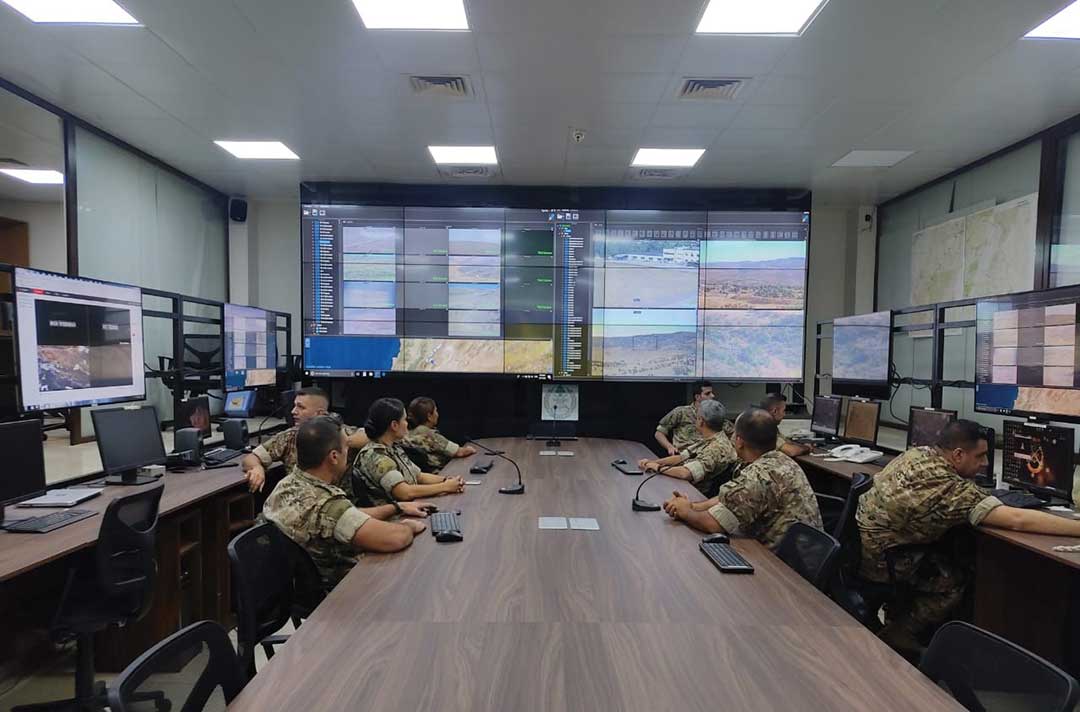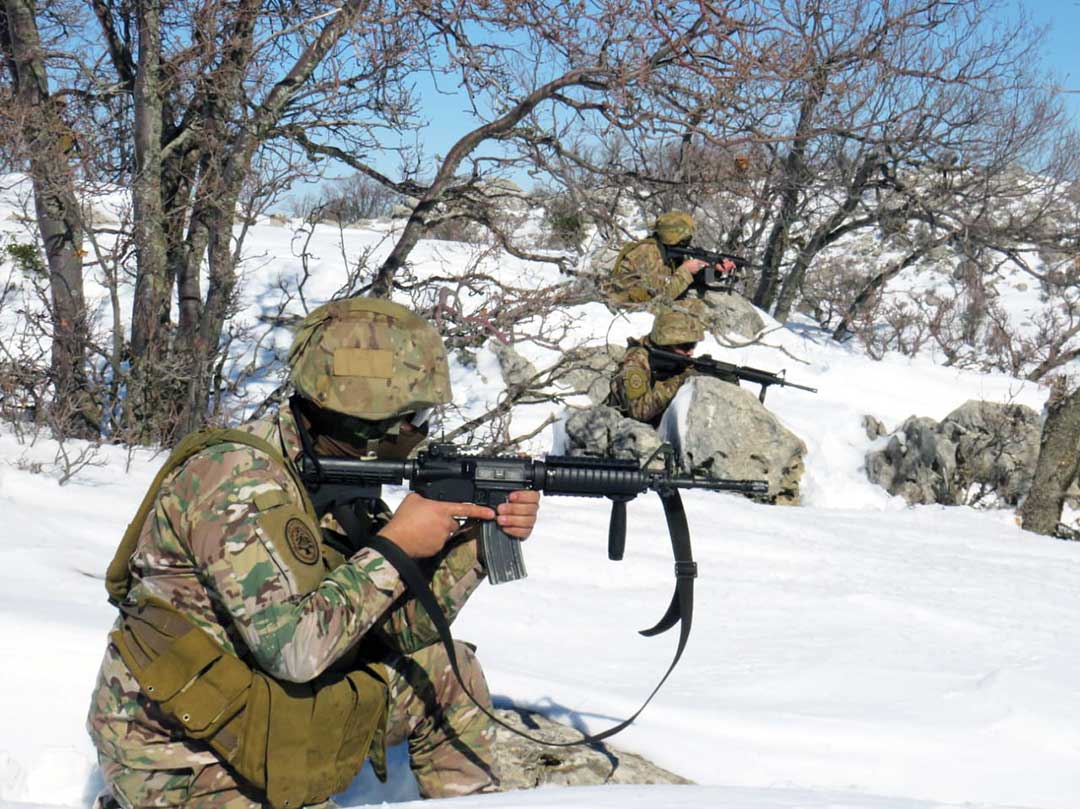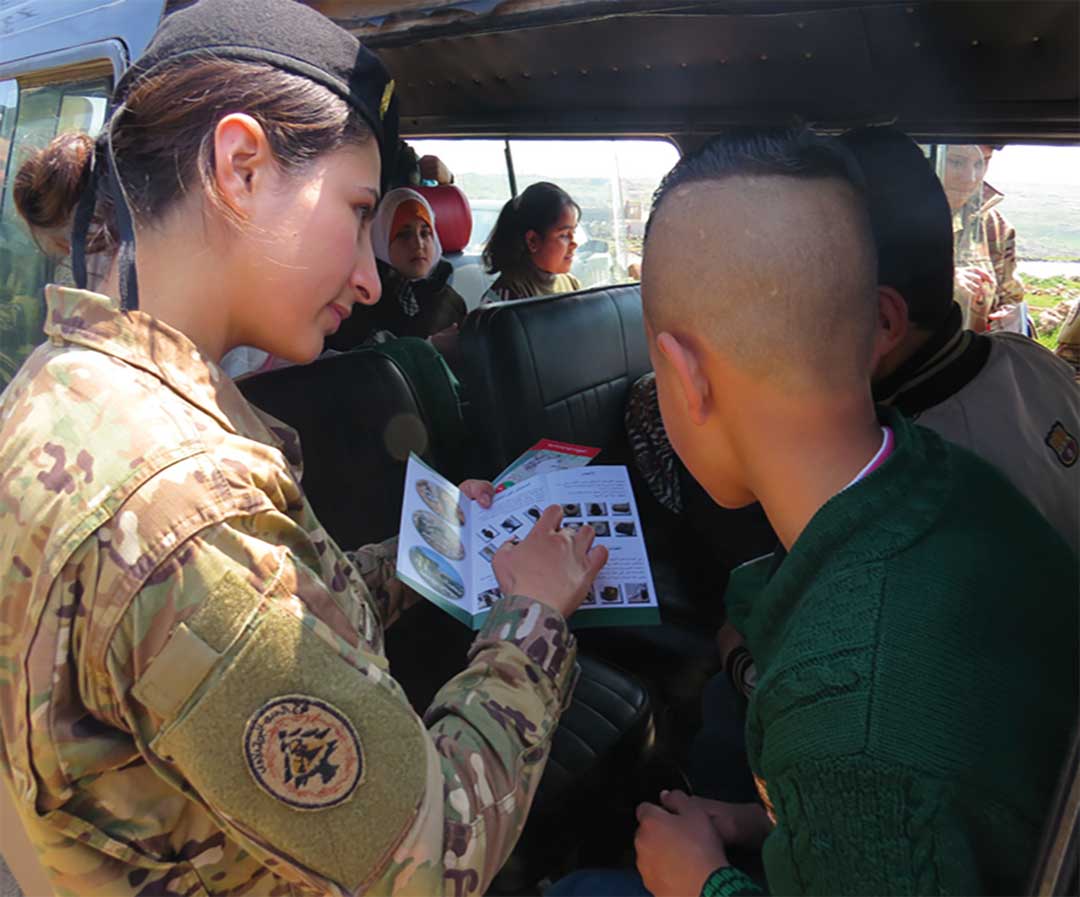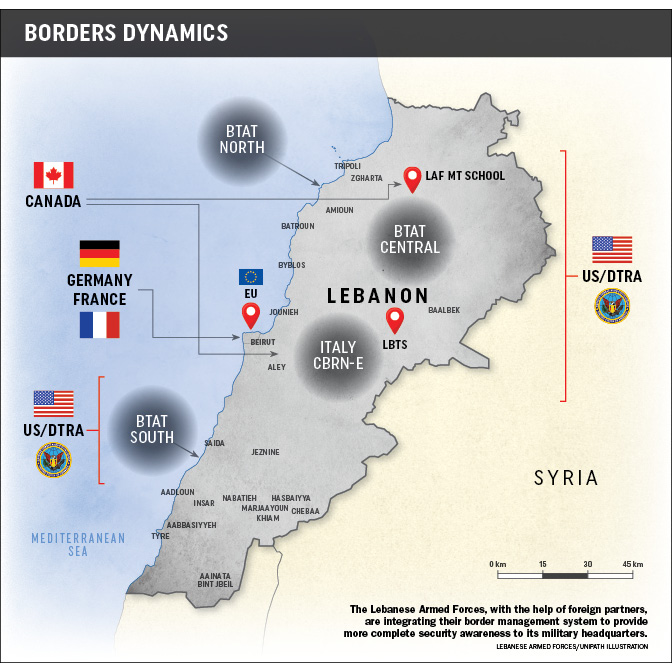Tighter Defense of a Turbulent Border
Lebanon has initiated an integrated border management strategy with international assistance
BRIG. GEN. JOE HADDAD, LEBANESE ARMED FORCES
A small country in a tense geostrategic environment, Lebanon experiences a disproportionate share of security challenges: terrorism, conventional warfare, asymmetric threats, manmade disasters, mass illegal migration and human trafficking, and smuggling of goods, weapons and illegal substances. All these problems place a strain on its borders, both land and maritime.
With an estimated population of 5.6 million, Lebanon hosts the most refugees per capita in the world, with about 1.5 million Syrian refugees in addition to about 500,000 Palestinian refugees living in overcrowded camps.
In 2006, the United Nations Security Council called upon the Lebanese government to secure its borders and all entry points to prevent illegal migration and smuggling. Lebanon, and the Lebanese Armed Forces (LAF) in particular, have established border control programs with international partners. Canada, the European Union, France, Germany, Italy, the Netherlands, Switzerland and the United States have all assisted the country with this critical issue.
In August 2006, the Joint Border Security Committee was established by governmental decree and put under the direct command of the Deputy Chief of Staff for Operations of the Lebanese Armed Forces. In addition to its core military responsibilities, the LAF is tasked with surveillance and control of land and maritime borders. They play a dominant role in protecting rural borders through the deployment of Land Border Regiments (LBR), including joint activities taking place in the framework of the Common Border Force on the northern frontiers with Syria.
The LAF also provides physical security at official crossing points on the northern and eastern frontier, at maritime ports of entry and at Rafic Hariri International Airport in Beirut. The General Security Directorate and Lebanese Civil Defense manage and regulate official land and maritime ports of entry while Internal Security Forces deploy as a second echelon in border communities and at Beirut airport.

Border dynamics
The year 2009 marked the moment when Lebanon assumed full management of its 225 kilometers of coastline and 375 kilometers of land borders. There are six legal crossing points of entry with Syria, three in the north, two in the northeast and one in the east. The southern frontiers are completely closed. Lebanon’s coast has two main harbors, Beirut and Tripoli; two minor ones in the south, Saida and Tyre; and several leisure and fishing ports.
Some territory on the northern and eastern land borders remains contested from colonial times with neighboring Syria, while the southern, western and northern maritime borders are not yet demarcated.
The physical geography of the land borders of Lebanon is extremely varied and has different implications in terms of security, entailing different types of operational challenges. With over 280 villages and towns, Akkar region is a northern borderland. Some villages straddle the border.
The human terrain is equally challenging because Akkar is historically one of the most deprived rural areas of Lebanon. The war in Syria and its stalemate, as well as the Syrian refugee crisis and its mass influx into the area, exacerbated the already dire local economic situation, causing an upsurge in crime at the borders, mainly in human trafficking.
High mountains, deserts and rugged terrain characterize the eastern borders. The population, though relatively sparse, is governed by clan and tribal bonds that overlap the borders, exacerbating the security challenges.
LAF’s border mission
Over the past 10 years, Lebanon has created four border regiments whose personnel are trained by the Land Border Training School. Their mission evolved throughout the years from observation and reporting to full deployment in border areas with defined sectors of responsibilities including the defense of the borders and conducting stability operations.
Pursuant to U.N. Security Council Resolution 1701, the LAF maintains a strong presence in the South, where it conducts stability operations in close cooperation with the U.N. Interim Force In Lebanon (UNIFIL).

International assistance
In light of the numerous challenges at the borders and the variety of security agencies involved — notably the additional involvement of Lebanese General Security and Lebanese Customs — it was necessary to coordinate activities to optimize and synchronize the use of resources. The unfortunate civil war in Syria put unprecedented pressures on the LAF Border Regiments in matters of illegal migration and associated cross-border crime. The LAF’s high command recognized the need to address gaps in expertise, skills and resources.
A well-oiled mechanism was established with the cooperation of international partners. At the strategic level, Lebanon drafted an integrated border management strategy followed by a detailed agency-centric action plan. At the operational and tactical level, the focus was on drafting a concept of operations and the appropriate legal framework for the Armed Forces integrating its different components — Land Borders Regiments, Air Force, Navy, Marine Commando Regiment, and Cyber Security — and establishing specialized training to accommodate the Land Border Regiments in view of their remote deployments.
The correct and practical solution was a blend of a decentralized training model with training delivered by specialized teams on site at the LBRs and the creation of the centralized LBR Training School. The school, with assistance from the Netherlands, is destined to become a regional center of excellence that will provide additional support to stabilize the Jordanian and Iraqi borders.
The EU financed and supervised the drafting of the IBM Strategy (Integrated Border Management Strategy) and Action Plan. This document took more than a year to produce with the full involvement and ownership of many Lebanese government ministries. Against all odds, the Lebanese government adopted the strategic border plan in 2019.
At the operational and tactical level, when it comes to border observation, the LAF provides the land and the engineering workforce and expertise, Great Britain provides the groundwork for the observation towers and tactical training for the guards, and the United States provides the electronics and the expertise for 24-hour surveillance of borders. This advanced detection technology used by border forces includes radar, cameras and sensors, some of them mobile.
The overall purpose of the project is to integrate information from border cameras and radar with information gathered by the LAF’s Naval Operations Center, Air Force assets and radio communications for analysis by the Joint Operation Information Center at LAF Headquarters.
In parallel with those efforts, the U.S. Defense Threat Reduction Agency supports LAF leadership to better integrate interagency roles and missions to address challenges arising from threats across air, sea, land and cyber domains. One special feature of this document is that it adopts a risk-based approach to border security and integrity. As such, the document is updated as risks change and evolve.
The Canadian Armed Forces deployed Arctic training teams in the Mountain Combat School in the Cedars Mountains to train the Land Borders Units, especially those deployed on the eastern borders.
A core value of this integrated approach is for each agency to understand other agencies’ roles. This breaks down barriers and builds cooperation. The introduction of Integrated Border Management took place through capacity-building activities (training, practical exercises, workshops, roundtables), supply of specialist equipment, building renovations, computerization and international exchanges.
The Netherlands played a tremendous role in empowering and equipping the Land Border Training School to enhance border governance. The school highlights inter-agency cooperation, a rights-based approach to improve border security, and trade facilitation and procedural transparency to reduce corruption. It contributes to the stability of border communities, especially those bearing a high burden of hosting displaced populations.
Lebanon has developed civilian-military projects in cooperation with local nongovernmental organizations, civil society organizations and security sector actors. Noteworthy is the Swiss project that supports a rights-based and gender-sensitive approach to migration and border management, and the Italian involvement in developing Chemical, Biological, Radiological, Nuclear and Explosive materials (CBRNE) basic courses in reconnaissance and decontamination procedures for units deployed at the borders.
The Border Control Committee (BCC) and the Land Border Training School have been vital in the implementation of Integrated Border Management. They helped develop contingency plans for emergencies, a major breakthrough for coordinating agencies’ first response in times of crisis at legal crossing points along the northern and eastern borders. FRONTEX, the European Union Border Agency, is partnering with the LAF through the BCC to conduct inter-agency training at official crossing points, including Beirut’s international airport.
The success of border management on land encouraged a similar project focused on the maritime domain dubbed Integrated Maritime Management. Regional conflict zones, poor maritime infrastructure, transnational organized crime, sea pollution, weapons proliferation, protection of underwater archaeological sites, human trafficking and, lately, illegal migration are among the most pressing challenges facing Lebanon.
Within the overarching goal to build resilience to withstand crises, Lebanon has engaged further ministries in defending the maritime domain. These include the ministries of transport, agriculture, health, economy, energy and foreign affairs. France has contributed to building a search and rescue center at the LAF Navy Headquarters at the Beirut Naval Base, and Germany is helping rebuild the base and financed the new LAF Navy School at Jounieh Naval Base.
It’s worth mentioning that the LAF is the first among Lebanese security agencies to create a gender department to better integrate women into the armed forces. Operational experience at the borders reflected a decisive need to involve female officers in dealing mainly with the trafficking of women. We hope that this major step in broadening participation in our Armed Forces will inspire other security agencies to do the same.

Conclusion
It’s remarkable that Lebanese border management remained a priority with our international partners despite the political and economic challenges in Lebanon and the devastation from the Beirut port explosion of August 2020. The trusted cooperation between the LAF and Canada, the EU, the U.S., and other European partners evolved into a collaboration allowing for wider Lebanese exposure to international standards and practices.
Several aspects of the IBM project support took shape over the years, from a growing and increasingly widespread understanding of the border management concept to the effective use of international aid, equipment and facilities, and the development of in-house training that acted as a solid platform on which to improve border security.
The strategy drew on a significant body of positive cooperation and mutual respect developed with the main beneficiaries: the Lebanese Armed Forces, Internal Security Forces, the General Security Directorate, Lebanese Customs Administration, the State Security Directorate, Lebanese Civil Defense and the Beirut Fire Brigade.



Comments are closed.